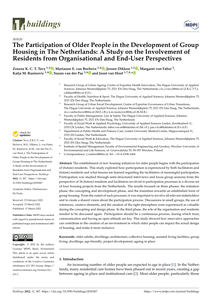The establishment of new housing initiatives for older people begins with the participation of (future) residents. This study explored how participation is experienced by both facilitators and (future) residents and what lessons are learned regarding the facilitation of meaningful participation. Participation was studied through semi-structured interviews and focus group sessions from the perspective of 34 (future) residents and facilitators involved in participation processes in a diverse set of four housing projects from the Netherlands. The results focused on three phases: the initiation phase, the concepting and development phase, and the transition towards an established form of group housing. From the outset of such processes, it was important to involve all relevant stakeholders and to create a shared vision about the participation process. Discussions in small groups, the use of references, creative elements, and the creation of the right atmosphere were experienced as valuable during the concepting and design phase. In the third phase, the role of the organisation and residents needed to be discussed again. Participation should be a continuous process, during which trust, communication and having an open attitude are key. This study showed how innovative approaches can contribute to the creation of an environment in which older people can impact the actual design of housing, and make it more inclusive. Original article at: https://doi.org/10.3390/buildings12030367 © 2022 by the authors. Licensee MDPI.
MULTIFILE

An enormous challenge has risen regarding our existing housing stock, as the result of ambitious agreements to reduce global carbon emissions. Until now the focus has been mostly on improving energy efficiency technically by ameliorating the energy performance of the building envelope. Insulation, controlled ventilation, new services and devices are deployed, saving and harvesting energy. New building components and production processes have been developed to smoothen obstacles in the role-out of large-scale implementation of these measures. Also effort has been put into non-technical solutions e.g. new financial arrangements, standards and business models. This has resulted in several successful pilots in the EU to retrofit dwellings towards net-zero energy levels. Still, large-scale implementation, especially targeted at owner-occupied dwellings is lagging behind. The hypothesis is that this is due to the fact that the challenge is still mainly addressed by following concepts that belong to the paradigm of the second industrial revolution. In this paradigm central coordination, proprietary development and vertical up-scaling are key and dwellers are neglected as an essential group of stakeholders in the transformation of their dwellings. This paper will reflect on the principles used in retrofitting using the successful Dutch programme of the Stroomversnelling as a case study. What are the consequences, especially for the position of dwellers, if we rethink the developments from concepts that belong to the paradigm of the third industrial revolution? In the reflection on necessary and possible future developments experiences and insights from Open Building will be used.
DOCUMENT
Senior co-housing communities offer an in-between solution for older people who do not want to live in an institutional setting but prefer the company of their age peers. Residents of co-housing communities live in their own apartments but undertake activities together and support one another. This paper adds to the literature by scrutinizing the benefits and drawbacks of senior co-housing, with special focus on the forms and limits of social support and the implications for the experience of loneliness. Qualitative fieldwork was conducted in eight co-housing communities in the Netherlands, consisting of document analysis, interviews, focus groups, and observations. The research shows that co-housing communities offer social contacts, social control, and instrumental and emotional support. Residents set boundaries regarding the frequency and intensity of support. The provided support partly relieves residents’ adult children from caregiving duties but does not substitute formal and informal care. Due to their access to contacts and support, few residents experience social loneliness. Co-housing communities can potentially also alleviate emotional loneliness, but currently, this happens to a limited degree. The paper concludes with practical recommendations for enhancing the benefits and reducing the drawbacks of senior co-housing. Original article at MDPI; DOI: https://doi.org/10.3390/ijerph16193776
MULTIFILE

Due to societal developments, like the introduction of the ‘civil society’, policy stimulating longer living at home and the separation of housing and care, the housing situation of older citizens is a relevant and pressing issue for housing-, governance- and care organizations. The current situation of living with care already benefits from technological advancement. The wide application of technology especially in care homes brings the emergence of a new source of information that becomes invaluable in order to understand how the smart urban environment affects the health of older people. The goal of this proposal is to develop an approach for designing smart neighborhoods, in order to assist and engage older adults living there. This approach will be applied to a neighborhood in Aalst-Waalre which will be developed into a living lab. The research will involve: (1) Insight into social-spatial factors underlying a smart neighborhood; (2) Identifying governance and organizational context; (3) Identifying needs and preferences of the (future) inhabitant; (4) Matching needs & preferences to potential socio-techno-spatial solutions. A mixed methods approach fusing quantitative and qualitative methods towards understanding the impacts of smart environment will be investigated. After 12 months, employing several concepts of urban computing, such as pattern recognition and predictive modelling , using the focus groups from the different organizations as well as primary end-users, and exploring how physiological data can be embedded in data-driven strategies for the enhancement of active ageing in this neighborhood will result in design solutions and strategies for a more care-friendly neighborhood.